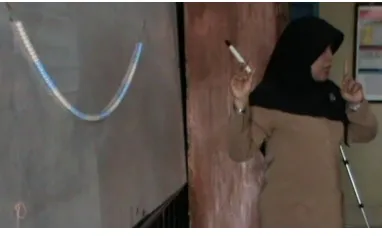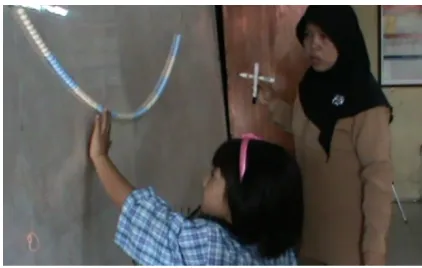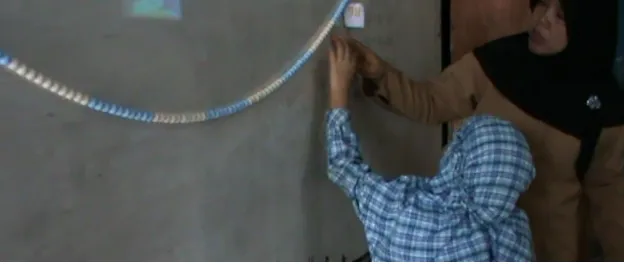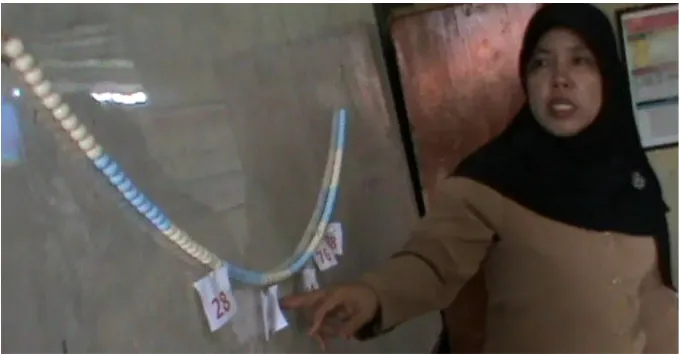USING STRING BEADS TO SUPPORT STUDENTS’ UNDERSTANDING
OF POSITIONING NUMBERS UP TO ONE HUNDRED
Sri Imelda Edo, Kamaliyah, and Zetra Hainul Putra
International Master Program on Mathematics Education (IMPoME) University of Sriwijaya, Indonesia
Abstract
Students with weak number sense get difficulties to know a position of a number on a number line. They sometimes put some numbers in wrong order or a distance among numbers on the number line does not represent the perceive situation. So, they need a support to understand positioning numbers on the number line. In this research, we designed an instructional activity to investigate how string beads support students’ understanding of positioning numbers up to one hundred. We used a qualitative research as an appropriate mean to achieve this research goal. This type of research is a greater emphasizing on holistic description, and phenomenon identified to be studied, students’ activities in finding positioning numbers in string beads. Twenty-seven students and a teacher of grade 1 in elementary school in Indonesia (SDN 179 Palembang) were involved in this research. The result of the teaching experiments showed that string beads with ten-structure can encourage students to more flexible in counting and understanding the positioning numbers based on number relations.
Keywords: positioning number, string beads, Realistic Mathematics Education (RME), ten-structure, and number relation
In line with the knowing positions of numbers, Menne (2004) stated that in order to be able to order and locate numbers domain up to one hundred, it is essential (and initially sufficient) that students are able to move quickly and flexible across the (imaginary) empty number line with jumps or composite jumps of 10 and steps or composite steps of one. Moreover, Treffers (Menne, 2004) observed that before students can operate an empty number linewith numbers, the following condition will be met. (1). The students must be able to count with tens and ones, (2) The students must be able to locate number on a string beads and on empty number line (3).They must be able to take a jump of ten from any number.
Sari (2008) also argued that Indonesian students can count the number of string beads but some students still make mistake in locating numbers in order or positioning the number, because of weak number sense and lack of measuring concept. In the other hand locating numbers on a string of beads could help students enhance their understanding of number relations. In order to address the need to improve mathematics instruction that leads primary school students to be accurate positioning the number up to one hundred, then we conducted a research which aimed to support students’ understanding of positioning number up to 100 using string of beads with ten-structure. The central issue of this research is formulated into a research question: How can string beads with ten-structures support students’ understanding of positioning numbers up to 100? We used Realistic Mathematics Educations (RME) approach in doing our research.
Realistic Mathematics Education
Freudenthal (1991) has an idea that mathematics as a human activity. It means that the students can experience mathematics when they are solving a meaningful problem. It became a principle of Realistic Mathematic Education (RME) that was developed in the Netherlands. In Realistic Mathematics Education (RME), students are given many opportunities to think and construct their own understanding. They are challenged to develop their own strategies for solving problems, and to discuss those strategies with other students.
mathematical system in which symbols are shaped, reshaped, and manipulated. Progressive mathematizing, both horizontally and vertically, is inspired by five educational tenets as follows.
Five Tenets of RME
Treffers (1987) has defined five tenets for Realistic Mathematics Education: 1. Phenomenological exploration
Freudenthal’s view of mathematics as a human activity requires an extensive phenomenological exploration that is aimed at acquiring a rich collection of contextual situation in which mathematical activities take place. The contextual situation is not merely a word problem, but it has to deal with a reality that makes sense for students with different levels. It should provide an ample space for students to build their own understanding and serve as a basis for model development.
2. Using models and symbols for progressive mathematization
The development from intuitive, informal, context bound notions towards more formal mathematical concepts is a gradual process of progressive mathematization. A variety of models, schemes, diagrams, and symbols encourages students in this gradual process.
3. Using students’ own construction and productions
Students’ own constructions deal with their actions, while their own productions deal with their reflection. This is, in fact, one of the most characteristic features of progressive mathematization in RME instruction theory. Students have freedom to construct their own path in learning under the teacher’s guidance. Furthermore, students’ own productions as the result of instruction functions as the mirror image of the teacher’s didactical activity. In this case, the teacher should help students to build on their understanding from what students know.
4. Interactivity
5. Intertwinement
The mathematical domain in which students are engaged in should be considered related to other domains, the intertwining of learning strands. In this design research the ‘positioning numbers up to 100’ through the measuring activity is intertwined with ‘measuring conceptions’. Students develop their understanding of measuring conceptions as well as their counting strategies in the measuring context.
Method
The research methodology that we use in this study is a qualitative. Qualitative research is research studies that investigate the quality of relationships, activities, situations, or materials. This type of research is a greater emphasize on holistic description—that is, on describing in detail all of what goes on in a particular activity or situation rather than on comparing the effect of a particular treatment or on describing the attitudes or behaviors of people.
There are five steps in qualitative research (Fraenkel & Wallen, 2010): (1) identification of the phenomenon to be studied - students’ activities in finding positioning numbers in string beads; (2) identification of the participants in the study - twenty-seven first grade students aged 6-8 years old in SDN 179 Palembang; (3) generation of hypotheses – string beads can support students’ understanding of positioning numbers up to one hundred that is designed into hypothetical learning trajectory; (4) data collection - used video recording and interviewed some students to get deeper information of their thinking process; (4) data analysis – data will be analyzed by holistic descriptive; and (5) interpretation and conclusion – using HLT as a guideline to interpret and to make a conclusion.
Hypothetical Learning Trajectory
Goal
The goal of this activity is to support students to understand positioning numbers up to one hundred using string beads with ten-structure.
Learning Activities
First, students are encouraged constructing strategies to calculate the number of beads on the string. Students’ awareness of structures are developed by showing the string beads which is consist of two colors, blue and white, in front of the class (Figure 1). The beads are arranged in ten-structure and students are guided to realize the structure of the beads. They are questioned how many beads on the string and how do they get the number of the beads. This activity will be followed by a discussion in which teacher guide the students to realize the structure of string beads in order to make them do quick counting. As a result of this activity, we expect when students calculate the number of the beads, they have already realized the structure of the beads arranged in group of ten.
Figure 1: 100 beads on the white board
Next, each student is given a number card which is consist of number in the range 1 to 100, and then some students put their numbers in string beads. This activity will be followed by a discussion in which teacher guides the students to realize the structure of string beads to make them find a position of number in string beads quickly besides counting one by one. As a result of this activity, we expect when students are asked to compare calculating the beads by counting and by skip counting that makes 10, they will be able to realize that structure helps them do fast counting in order to find a positioning number correctly in string beads.
positioning number faster than other groups, thus this game forces them to recognize the structure of string beads. We assume students first might need more time, but as soon as they recall the structure, they will be able to play this game easily. As a result of this activity, we hope students will become aware the benefit of having structured object.
Conjecture of students strategies
Students’ strategies in determining the number of beads and in locating number cards on string beads might vary, but we conjecture students will use counting all (counting one by one), use group of tens, group of twenties, or group of fifties.
Result and Analysis
When the teacher asked students how many beads on the string, some students directly said one hundred. Even though they did not count each color of the beads consisting of ten beads, they could estimate the number of beads was one hundred. Other students said ninety and one hundred and ten. It means that they also could predict the number of the beads was around one hundred. However, since the teacher required other different answers, there were students answering it by saying a thousand, sixty, and two hundreds.
Figure 2: A student counted by twenty.
Furthermore, the teacher prepared students to continue the next activity. She gave a number card that contains numbers from 1 to 100, for each student, and asked them to not tell to their friends what number that he/she got. This rule made students pay more attention to the learning activity so that all of them focused to what teacher said. The teacher wrote zero at one end and one hundred at the other end of string beads. Then, the teacher mentioned one of the two digit numbers and let students who had the number to go to the front of the class put this number in string beads. First a student, who had number 98 came to the front of the class to locate his number card on the string beads. After thinking for a few minutes, he pointed wrong position in string beads. The teacher asked him to put the number card but he still seemed uncertain. The teacher asked other students who were willing to help him. There was another student forwarded to the front of the class to help him. In order to find the position of 98, both of them counted one by one from the first bead. In determining the position of 98, both two students did not use ten-structure although in the previous learning activity the students had used it. It indicated that the previous activity had not provided strong influence for the two students. After that, the teacher asked students by saying,
Teacher : “Is there any other way which is different from two students’ strategy?” Student A:”Ten, ten, ten, ten, ten, ten, ten, ten, ten, ten.” (pointing the beads)
Teacher :”Wait a minute, ten… (pointing the beads and expecting student A continue her words)
Figure 3: A students counted by ten to get 98 Teacher :”ninety, here is ninety, after that?”
Student A:”one hundred.” Teacher :” is this?”
Student A:”this is one hundred.”
Teacher :”yes, this is one hundred and where is 98?” Student A:”ooo, yes.”
Teacher :”what is your way?”
Student A:”what way did you mean mom?”
Teacher :”the way that you can get 98. Here is one hundred, where is ninety eight?” Student A:”so…”
Teacher :”so…?”
Student A:”so, so…ninety eight…”
Teacher :”ooo, you counted till eight, didn’t you?” Student A:”yes.”
The conversation showed Student A used group of tens to determine the position of 98. However, she confused to explain why 98 was there and she was quite difficult to understand the position of 98. She could understand ten-structure but could not combine between tens-structure and units. Other students experienced the same thing as Student A.
what it meant. Actually, it seemed that he realized the relations between 96 and 98 that is 96 is put before 98. The teacher repeated this activity for several times. At the end of this activity, even though there were some students still used counting one by one, other students had noticed the group of ten of string beads and the students could realize that structure helped them did fast counting in order to find the positioning numbers correctly in string beads.
Students worked in group in the last activity. The teacher told the students that after this there would be a game, and the students seemed enthusiastic. The teacher gave a number card to each group and asked the groups to think where the position of number card in the string beads was. A group had to think quickly so that they were able to put a number card faster than other groups. After all groups had located their number card in string beads, teacher organized whole class discussion to verify students’ work. There are six groups altogether and just two groups put it correctly, number 40 and 28 (Figure 4). The others groups seemed to have misunderstood the position of their numbers. They put 64 on 54, 52 on 42, 76 on 66, and 88 on 73 as, for instance, the following conversation.
Figure 4: The teacher pointed the position of 52 Teacher :”52, is it correct?”
All students :”correct.” Teacher :”Counts it first.”
All students :”ten, twenty, thirty, forty, fifty two.” (teacher pointed 42nd bead)
Teacher :”please, count it again.” Students :”it is wrong.”
Student A :”fifty three.”
Teacher :”please, count it again.”
All students :”ten, twenty, thirty, forty, fifty two.”
Teacher :”here is forty, here is fifty, so, what is it?” (pointing the beads) All student :”fifty three.”
Student B :”forty three, oh, forty two.”
Teacher :”so, this is right or wrong?” (pointing number card 52) All students :”wrong.”
It was quite difficult for the teacher to make the students realize that, for example, after 50 is 51 while pointing 51st bead. As in the previous activity, the students were still quite difficult to
combine between tens-structure and units. The students spontaneously said sixty after fifty though the teacher pointed 51.
However, when the discussion was continued to verify the position of the others number cards, students gradually knew that the position of number cards was wrong. The previous discussion had influenced them in paying attention to ten-structure. Students became aware the benefit of having structured objects. Then, the teacher together with the others groups gave applause for the two groups who locate the number card correctly.
To increase students’ skill in understanding the location of number, the teacher asked two students to put number cards in the string beads. These students can put 76 and 88 correctly and other students also agree with them. Again, the teacher said to the students who can put these number cards—without showing the numbers contained in each number card, and would be rewarded. Two students came to the front of class and put the number cards correctly. The first student used group of tens strategy as he had just already learned but the second student used countdown strategy. The second student counted from 28, 27, 26, 25, 24, 23, and 22 in order to find 21. Yet, the time was over; the teacher did not discuss their solutions. Finally, the teacher guided students to conclude what they had learned in that day.
Conclusion
number of beads on string provided by teacher is 90, 110, 200, 60, and 100, in a while, all of them could mention the correct number of beads on string which consist of 100 beads. Though they had awareness the structure of string beads, few students still use counting on to find the position of numbers. It could be seen that the students lacked of knowledge about relationships between the numbers as quantities and the positioning numbers refer to ordinal number. Moreover, the students could approximately the position of numbers on the string beads more quickly, it could be seen when the students put the number cards on the string beads which 10-10 pattern in correct positioning in quick time, though a few students made mistake because they did not more accuracy and because they didn’t start count from the first bead, but they started from their friends card number which had wrong positions.
This activity implied that the students had understanding of number relations. Alternating the color by tens in a string of beads allows students to see the beads as pieces of ten beads, which leads to counting by tens. The pattern helped the students to count by only looking at how many pieces of ten beads and how many ones remaining from tens. It was also found that the string beads pattern could encourage students to count backward from tens for ones which greater than five. It could be expected that because the ones greater than five nearer to ten. So, we concluded that the string beads with ten-structure could support the students understanding of positioning numbers up to one hundred.
References
Cross, C.T., Taniesha, A.W. & Heida, S. 2009. Mathematics Learning in early Childhood. Washington, D. C: The National Academic Press.
Fraenkel, Jack R. & Wallen, Norman E. 2010. How to design and evaluate research in education seventh edition. Singapore : McGraw-Hill
Menne, J. 2001. Jumping ahead in Classroom-based Research in Mathematics Education. The Netherlands, Amersfoort: Wilco.
Sari, P. 2008. Design Research on Addition and Subtraction up to 100: Using Mental Arithmetic Strategies on Empty Number Line at the second grade of SDN Percontohan Komplek IKIP, Jakarta. Prosiding Konferensi Nasional Mathematika [ Proceeding of Mathematics National Conference]. 14, 833 – 839.
van den Heuvel-Panhuizen, M. 2001. Children Learn Mathematics: A Learning-Teaching Trajectory with Intermediate Attainment Targets for Calculation with Whole Numbers in Primary School. The Netherlads: Freudenthal Institute, Utrecht University.



